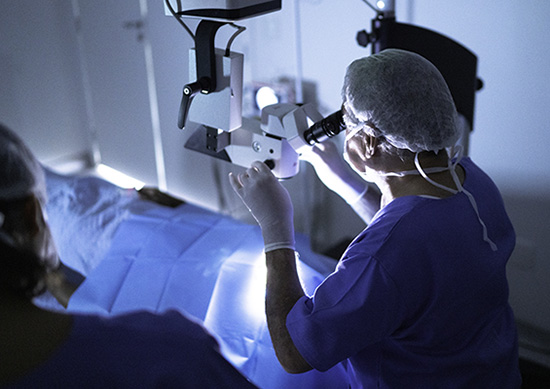Cataract Surgery
About Cataract Surgery
When a cataract advances to the point of visual disability, cataract surgery is necessary to help restore vision. Cataract surgery is a relatively simple outpatient procedure where the eye’s natural, cloudy lens is removed and replaced with an artificial lens, called an intraocular lens (IOL). The IOL cannot be seen or felt by the patient and becomes a permanent part of the eye.

Preparing for Cataract Surgery
BEFORE SURGERY
- Your surgeon will measure your eye to determine the proper focusing power for your IOL. Also, you will be asked about any medicines you take. You might be asked not to take some of these medicines before surgery.
- You may be prescribed eye-drop medicines to start before surgery. These medicines help prevent infection and reduce swelling during and after surgery.
THE DAY OF SURGERY
Cataract removal surgery may be done in an outpatient surgery center or in a hospital. Here is what will happen:
- Your eye will be numbed with eye drops or with an injection around the eye. You may also be given a medicine to help you relax.
- You will be awake during surgery. You may see light and movement during the procedure, but you will not see what the doctor is doing to your eye.
- Your surgeon looks through a special microscope. He creates tiny incisions (cuts, created by blade or a laser ) near the edge of your cornea. The surgeon uses these incisions to reach the lens in your eye. Using very small instruments, he will break up the lens with the cataract and remove it. Then he puts your new lens into place.
- Usually your surgeon will not need to stitch the incisions closed. These “self sealing” incisions will close by themselves over time. A shield will be placed over your eye to protect it while you heal from surgery.
- You will rest in a recovery area for about 15–30 minutes. Then you will be ready to go home.
POST-SURGERY RECOVERY
For days or weeks after surgery you willfollow these guidelines:
- You may have to use eye drops after surgery. Be sure to follow your doctor’s directions for using these drops.
- Avoid getting soap or water directly in the eye.
- Do not rub or press on your eye. Your ophthalmologist may ask you to wear eyeglasses or a shield to protect your eye.
- You will need to wear a protective eye shield when you sleep.
- Your ophthalmologist will talk with you about when you can safely exercise, drive or do other activities again.
RISKS OF CATARACT SURGERY
Like any surgery, cataract surgery carries risks of problems or complications. Here are some of those risks:
- Eye infection.
- Bleeding in the eye.
- Ongoing swelling of the cornea on the front of the eye which might limit vision and necessitate further surgery
- Swelling of the retina (the nerve layer at the back of your eye).
- Detached retina (when the retina lifts up from the back of the eye).
- Damage to other parts of your eye.
- Pain that does not get better with over-the-counter medicine.
- Blurred vision.
- Seeing halos, glare, and dark shadows.
- Seeing floaters.
- Vision loss.
- The IOL implant may become dislocated, moving out of position.
- During cataract surgery, the cataract or a piece of the cataract might fall into the back of the eye. This necessitates further surgery.
Cataract surgery will not restore vision lost from other eye conditions, such as macular degeneration, glaucoma, or diabetic retinopathy. Your ophthalmologist will talk with you about the risks and benefits of cataract surgery.
Traditional vs. Laser Cataract Surgery
You should consider surgery when cataracts keep you from doing things you want or need to do. If you are planning to have cataract surgery, you may have two surgical options: traditional or laser-assisted.
TRADITIONAL CATARACT SURGERY: Traditional cataract surgery is an operation that entails making a tiny incision in the cornea by hand. Through this incision, the surgeon inserts an instrument about the size of a pen tip. This instrument breaks the cloudy lens into pieces and removes them from the eye.
Once the cataract is removed, a cataract replacement lens is inserted through the same tiny incision and set into position. This replacement lens (IOL) may remove the need for glasses or bifocals.
The procedure is done on an outpatient basis, one eye at a time, and usually lasts between 10 to 15 minutes. Dr. Bannan’s staff will walk you through detailed information on caring for your eyes post-surgery. Most patients see well enough return to work or daily activities after a couple of days.
LASER CATARACT SURGERY: Laser cataract surgery involves the use of a sophisticated laser system to access and remove the cataract. First the laser creates a precise circular opening in the cornea and then it softens and breaks up the cataract into tiny pieces for gentler and easier extraction.
Once the cataract is removed, an intraocular lens is inserted through the same tiny incision and set into position. This replacement lens (IOL) may remove the need for glasses or bifocals.